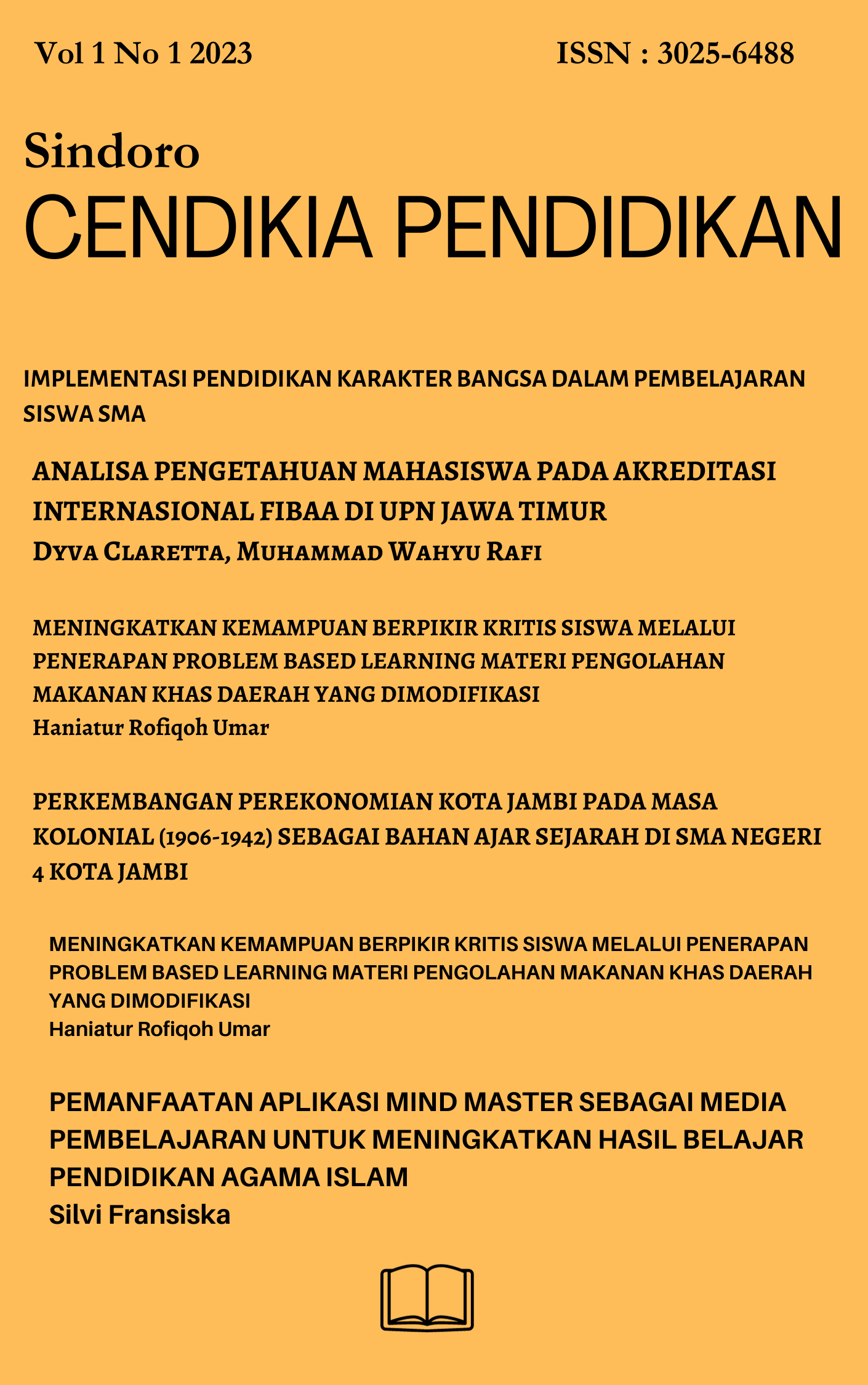PENINGKATAN KEMAMPUAN BERPIKIR KRITIS MELALUI MODEL PROBLEM BASED LEARNING (PBL) BERBASIS ETNOSAINS PADA MATERI SIFAT-SIFAT CAHAYA KELAS V SDN KLITIK 1 NGAWI
Main Article Content
Abstract
This research aims to improve students' critical thinking skills through a problem-based learning model based on ethnoscience in grade 5 at SDN Klitik 1 Ngawi. The research method used is Classroom Action Research (PTK) with a McTaggart design, employing a cyclical process with two cycles. Each cycle consists of four stages: 1) planning, 2) implementation, 3) observation, and 4) reflection. Data collection techniques included interviews, tests, and observations. The data analysis results show an increase in students' critical thinking skills. In cycle 1, the average score was 71 with a completion rate of 63%, which increased to an average score of 84 and a completion rate of 88% in cycle 2. The problem-based learning model based on ethnoscience used in the Integrated Science (IPAS) learning process gradually improves students' critical thinking abilities.
Penelitian ini bertujuan untuk meningkatkan kemampuan berpikir kritis peserta didik melalui model pembelajaran problem based learning berbasis etnosains di kelas V SDN Klitik 1 Ngawi. Metode Penelitian yang digunakan adalah metode Penelitian Tindakan Kelas (PTK) rancangan Mc Taggart dengan alur berulang sebanyak 2 siklus. Setiap siklus memiliki 4 tahapan yaitu 1) perencanaan, 2) tindakan, 3) observasi, 4) refleksi. Teknik pengumpulan data meliputi wawancara, tes, dan observasi. Hasil analisis data dari penelitian ini menunjukkan peningkatan kemampuan berpikir kritis peserta didik. Pada siklus 1 nilai rata-rata 71 dengan presentase ketuntasan 63% mengalami peningkatan pada siklus 2 dengan nilai rata-rata 84 serta presentases ketuntasan sebesar 88%. Model pembelajaran problem based learning berbasis etnosains yang digunakan dalam pembelajaran IPAS dapat meningkatkan kemampuan berpikir kritis peserta didik secara bertahap.
Article Details

This work is licensed under a Creative Commons Attribution-NonCommercial 4.0 International License.
This work is licensed under a Creative Commons Attribution-ShareAlike 4.0 International License.
Authors who publish with this journal agree to the following terms:
- Authors retain copyright and grant the journal right of first publication with the work simultaneously licensed under a Creative Commons Attribution License that allows others to share the work with an acknowledgement of the work's authorship and initial publication in this journal.
- Authors are able to enter into separate, additional contractual arrangements for the non-exclusive distribution of the journal's published version of the work (e.g., post it to an institutional repository or publish it in a book), with an acknowledgement of its initial publication in this journal.
- Authors are permitted and encouraged to post their work online (e.g., in institutional repositories or on their website) prior to and during the submission process, as it can lead to productive exchanges, as well as earlier and greater citation of published work
References
Abidin, Z., & Sulaiman, F. (2024). The Effectiveness of Problem based Learning on Students’ Ability to Think Critically. Zabags International Journal of Education, 2(1), 1–6. https://doi.org/10.61233/zijed.v2i1.13
Adawiyah, R., Asbari, M., & Damayanti, M. S. (2023). Tiga Level Proses Belajar Efektif: Fundamental, Insightful Knowledge, Specific Skill. Literaksi: Jurnal Manajemen Pendidikan, 1(02), 339–342. https://doi.org/10.1111/literaksi.v1i02.394
Adha, A. R. N., Makkasau, A., & Rahayu, A. (2024). Peningkatan Keterampilan Berpikir Kritis Siswa Kelas V melalui Penerapan Model Problem based Learning. Pinisi Journal PGSD, 4(2), 692–698.
Alkurnia, R., Susilaningsih, S., & Sudiyanto, S. (2019). The effect of critical thinking on students’ accounting competency in vocational high school. Jurnal Pendidikan Vokasi, 9(3), 270–279. https://doi.org/10.21831/jpv.v9i3.27664
Arif, D. S. F., Zaenuri, & Cahyono, A. N. (2020). Analisis Kemampuan Berpikir Kritis Matematis Pada Model Problem based Learning (PBL) Berbantu Media Pembelajaran Interaktif dan Google Classroom. Prosiding Seminar Nasional Pascasarjana, 3(1), 324–328. https://proceeding.unnes.ac.id/snpasca/article/view/594
Arikunto. (2021). Penelitian Tindak Kelas (Edisi Revisi). Bumi Aksara
Dekker, T. J. (2020). Teaching critical thinking through engagement with multiplicity. Thinking Skills and Creativity, 37. https://doi.org/10.1016/j.tsc.2020.100701
Fahrozy, F. P. N., Irianto, D. M., & Kurniawan, D. T. (2022). Etnosains sebagai Upaya Belajar secara Kontekstual dan Lingkungan pada Peserta Didik di Sekolah Dasar. EDUKATIF : JURNAL ILMU PENDIDIKAN, 4(3), 4337–4345. https://doi.org/10.31004/edukatif.v4i3.2843
Mandasari, J., Titin, T., & Juniardi, D. (2024). Pengaruh Pendekatan CRT dalam Meningkatkan Hasil dan Motivasi Belajar Siswa. EKSAKTA : Jurnal Penelitian Dan Pembelajaran MIPA, 9(1), 81–86.
Nugroho, A. S., Agus, F., & Firmansyah, H. (2021). Peningkatan Kemampuan Berpikir Kritis dengan Model Pembelajaran Concept Setence Berbantukan Media Kartu Kata pada Siswa Sekolah Dasar. ELSE (Elementary School Education Journal, 5(2), 261–263.
Saputri, A. N., & Desstya, A. (2023). Implementasi Pembelajaran IPA Sekolah Dasar Berbasis Kearifan Lokal di Kabupaten Sragen. ELSE (Elementary School Education Journal), 154–165. https://doi.org/10.30651/else.v7i2.18280
Sastradewi, N. M. P. (2022). Meningkatkan Kemampuan Berpikir Kritis Siswa Melalui Multimedia Interaktif Berbasis Problem Solving Pada Muatan Pelajaran IPA. Jurnal Media Dan Teknologi Pendidikan, 2(1), 10–19. https://doi.org/10.23887/jmt.v2i1.44855

